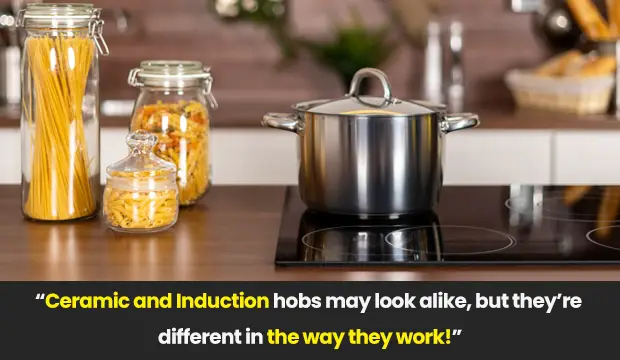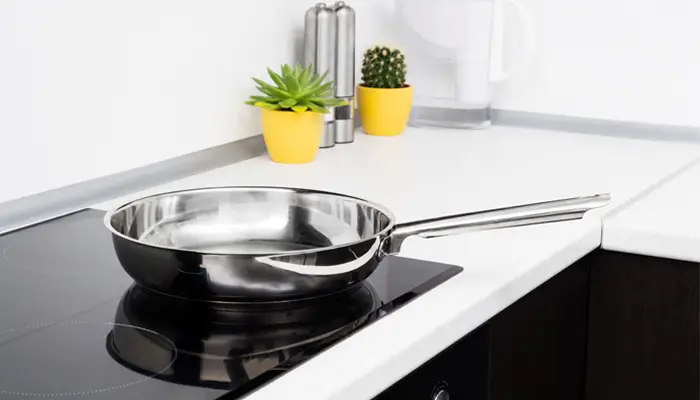The latest trend in kitchen appliances is the induction hob. It’s versatile, energy-saving and cooks with lightning-fast results.
The principle of using electro-magnetics was established more than a century ago, but it’s only been in the last decade that this convenient, easy-to-clean system has finally begun to revolutionise our kitchens.
What is an Induction Hob?

In appearance, an induction hob has the same sleek surface as an electric hob that’s fitted with a ceramic glass plate. However, the induction hob has several distinct advantages.
- Stay cool surface: The process of cooking with an electromagnetic field directly heats only the base of the pan. It completely eliminates the need for heating the elements or burners and the surface of the hob. It allows the ceramic glass plate to remain cool to the touch at all times.
- Responsive controls: An induction hob provides instantaneous control over the heat used for cooking. As it’s only the base of the pan that absorbs any heat, the temperature can be altered with immediate effect. If the control knob is switched off just as the pan’s contents are about to boil over, spillages can generally be completely prevented as the heat is instantly removed. In conventional hobs, so much heat is stored in the burners, elements and the hob itself, that even when the heat is reduced cooking continues, resulting in food spilling over or burning. The induction hob and its heating mechanism remain cold regardless of how much heat is being used to cook food.
- Easy clean: Because of its stay-cool surface design, spillages can be wiped away immediately – there’s no heat so no debris will stick to the hob. Just wipe away any spills, no need to wait for the hob to cool down.
- Advanced settings: Many induction hobs are equipped with touch-sensitive controls, enabling you to easily increase or reduce the cooking temperature in an instant, even if your hands are wet. Some controls also include memory settings for consistent results when cooking certain dishes.
- As good as new: Ceramic glass hobs are susceptible to being scratched or even chipped when pans are accidentally pulled across the surface. However, the permanently cool induction hob can safely use a thin silicone membrane to protect the surface without hindering the effectiveness of cooking.
How does an Induction Hob work?
An induction hob is the fastest, most energy-efficient method of cooking. It saves time and reduces the amount of money spent on fuel bills. Its secret lies in how it uses the magnetic field beneath the glass surface to produce heat.
- Energy-saving activation: The electromagnetic field that is created whenever the main power source is switched on, is only complete when a magnetised pan is placed on the hob. The process of heating the pan’s base is immediately activated and ceases the moment the pan is removed. The system uses up to ninety percent of its energy for direct cooking alone. By comparison, a traditional hob wastes a great deal of energy heating the burners, elements and surrounding surfaces.
- Copper coils: Each cooking zone consists of copper wire rolled into a large, flat disc with an alternating electrical current flowing along its length. When a compatible pan is placed on the hob’s surface its magnetised ferrous content immediately attracts an eddy current.
- Resistive heat: While the eddy current continues to flow, it repeatedly collides with the magnetic layer in the pan, causing rapid oscillations, or vibrations, that quickly produce resistive heat in the pan’s base. The heat is then transferred to the food inside the pan. Lift the pan off the surface and the magnetised current is immediately cut.
How do I know if I have an Induction Hob?
As soon as the main power source is switched on it sets up the electromagnetic field inside the hob. This produces a constant, low humming noise, whereas an electric ceramic hob is silent.
Some models also include a fan. Lightweight saucepans can also rattle as the oscillating current reacts with the base of the pans.
Types of Induction Hobs
There is now more choice than ever regarding the number of cooking zones an induction hob contains. Like a traditional hob, many have four, with a zone in each quarter.
Two-zone and three-zone hobs are also available, though these tend to be more common in the far east.
Zoneless induction hobs allow up to five pans to be placed simultaneously in any location on the hob. A portable design with a single zone is becoming increasingly popular as an alternative to an electric kettle.
Water can be boiled for tea or coffee in a fraction of the time as the pan is heated directly, without having to wait for an element to reach the right temperature.
What happens if you use a normal pan on an Induction Hob?

If a pan without a magnetised layer is placed on an induction hob, it won’t activate any heat and the food will remain uncooked.
Pans have to include a layer of ferrous, magnetised metal to attract the current flowing in the copper coil. Suitable metals include iron and various grades of magnetised stainless steel.
The base layer also needs to be relatively thick as a thin sheet won’t provide an adequate amount of resistance to the magnetic current to cook effectively. The suitability of a pan can easily be tested by placing a magnet on its base.
The more difficult it is to release the magnet, the more effectively the pan will cook. Most new pans contain layers of ferrous metal along with aluminium, an efficient distributor of heat, making them suitable for use with any hob.
Wrapping up
An induction hob is many times faster than a conventional stovetop and provides instant, effective control, making the hob easy to use and clean.
It can often be slightly more expensive to install, but its superior performance in cooking food fast while using less energy can quickly offset the initial investment.
